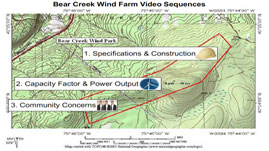Teachers' Domain - Digital Media for the Classroom and Professional Development
User: Preview

Source: Energy Education for the 21st Century.
This interactive contains video interviews with a construction project manager, who explains the process of constructing a wind farm. He describes the specifications and construction of the wind turbines, their capacity and power output, and community concerns.
At the Bear Creek Wind Farm on Bald Mountain construction project manager Ed DeJarnette placed the towers of wind turbines on top of an almost solid rock foundation. The foundation was designed as an inverted T, 54 feet across at the bottom and 14 feet at the top, surrounded by backfill to hold it in place. The wide foundations allowed the towers to be relatively narrow, only 15 feet at the base and 11 feet at the top.
Building the tower was easy, like tinker toy construction, compared to the difficulty of trucking turbine parts into the mountains during winter. Trailers as long as 180 feet snaked around hairpin curves and up a slippery, snowy road to the top.
The construction team worked closely with the Department of Environmental Protection (DEP) to protect pristine creek waters from dirt and sand runoff during construction. Studies revealed a minimal impact on wildlife; in this area birds tend to gather in the valley for food and warmth, and not many bats are found on the ridge.
To determine capacity before construction began, the project team collected wind information from three meteorological towers. They found winds blew hard enough to be profitable, i.e., from the southwest for 30 to 60 miles an hour for more than eight hours out of 24. If 12 turbines spun at once, they could produce a maximum of 2 megawatts apiece, enough electricity to light up a fairly large town.
The wind turns a fairly large blade on a turbine that spins a shaft connected to a generator that makes electricity. This electricity enters an electric company's grid via a high-powered line down the mountain. The electrical power flows where it's needed like water in a hose. If there's extra power, it can be sold elsewhere.
Two companies own Bear Creek Wind Farm and sell portions of what they own to investors. To build the wind farm the owners leased private land directly from five property owners. The construction project manager feels it's easier from a business point of view to work out deals with private property owners than with the owners of public land, i.e. voters. Voters might question the location of a wind farm on public land for a variety of reasons.
To learn more about efforts in Pennsylvania to produce electricity using wind power, check out Pennsylvania Energy: Wind.
To see how solar and wind power are converted into electricity on a small scale, watch an engineering design professor's explanation Center for Sustainability at Penn State University: Energy System.
 Loading Standards
Loading Standards